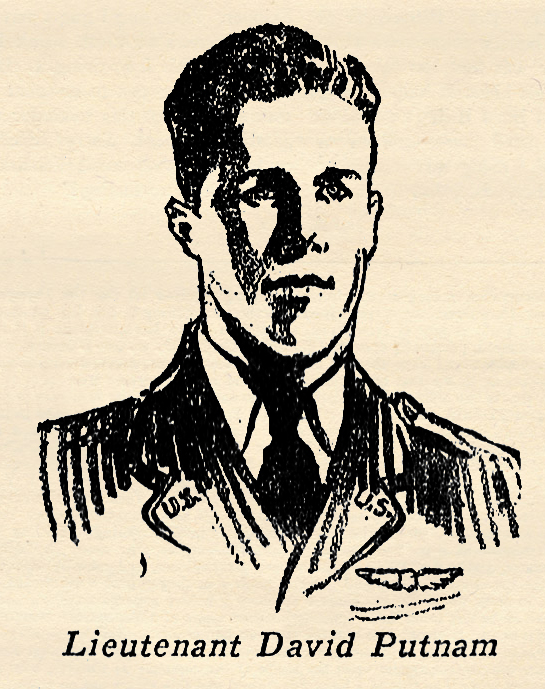Amidst all the great pulp thrills and features in Sky Fighters, they ran a true story feature collected by Ace Williams wherein famous War Aces would tell actual true accounts of thrilling moments in their fighting lives! This time we have Lieutenant David Putnam’s most thrilling sky fight when he scored five victories in one flight!
Lieutenant Putnam  was one of the American flying aces who saw service under two flags. He began his career with the French before America entered the war. At first he served with the Ambulance Corps, but was later transferred to aviation, where he established a reputation as one of the most daring flyers on the front.
was one of the American flying aces who saw service under two flags. He began his career with the French before America entered the war. At first he served with the Ambulance Corps, but was later transferred to aviation, where he established a reputation as one of the most daring flyers on the front.
As late as July, 19I8, he was still flying with the French, but transferred to the American Forces in August. He was officially credited with 10 victories, but his actual record was over twice that number. Confirmations for his victories were hard to get, for he always flew alone and operated far within the German lines. But flyers who flow in the same squadron with him acknowledged his ability and superiority. The account, given below was secured from him when he was still a Sergeant with the French Flying Corps.
FIVE VICTORIES IN ONE FIGHT
by Lieutenant David Putnam • Sky Fighters, November 1933
My most thrilling air fight is hard to pick. All of them are thrilling in one way or another. Some maybe more than others. I hesitate to choose the most thrilling, so I shall give an account of my most successful flight.
That is the time I knocked down five Boches in a single fight. It was during the big push of the Germans on the Marne on June 5th, 1918. I was still flying with the French, and was cruising alone far behind the enemy lines in the region of Fere-en-Tardenois, when I glimpsed five, six, seven—yes, ten black specks slightly above the horizon line four or five kilometers farther in.
I circled slowly and watched the specks while they grew and took shape. As they approached closer to me I saw that they were German Albatrosses flying in layer formation. For an instant I debated with myself whether to run for home or stay and attack. The odds of ten to one were against me. I came to a snap decision, poured on all throttle, and raced right for their midst.
I figured that my sheer audacity would momentarily disrupt them. In that moment I might have a chance to get in some telling blows.
I kited right for the middle of the formation, aiming to get my plane between the ten enemy ships in such a position that they couldn’t shoot at me without danger of shooting down their own comrades.
My tactics were successful.
The Albatrosses spread and let me in their net; then they all turned as one and came in at me with guns blazing. It was what I wanted. I banked tightly, letting the bullets spray around me until the Albatrosses came in very close. The German guns suddenly stilled, however, when they saw their tracers streaming perilously close to their own comrades’ planes.
That was the moment I was awaiting. I opened up with both guns. One Albatross fell immediately. It was my seventh victory. I banked quickly and lined on another. It burst into flames.
The Germans began to scatter now, darting every way, up and down and to both sides, to get out of their own lines of fire. I followed two who wheeled away from me, got my sights on one, pressed the Bowdains. It fell off quickly. I lined the other instantaneously, still holding my triggers down. The plane burst into flames. Both went down together.
My slugs couldn’t seem to miss. I was just lucky, I guess. I felt a crackle behind my back. I turned my head quickly, saw a Boche hanging on my tail and peppering me with lead. His tracer was close, too close!
I dived, then reversed.
Again I was lucky. I came out right under his belly and gave him both guns. He fell off in a slow spin. It was my fifth victory in that single dog-fight. The Germans must have had enough. The five Albatrosses turned and ran away.
I let them go, certain that I couldn’t rely on sheer luck any longer; for sheer luck it most surely was. I looked at the clock on my dash as I kited for home. The whole flight had lasted only about eighteen or twenty minutes!
But when I got back, I found that only one of my victories had been observed. It was the only one I got credit for—officially. Yet, what did it matter? Actual results are what count. Whether it is a matter of record or not is unimportant.







 was one of the American flying aces who saw service under two flags. He began his career with the French before America entered the war. At first he served with the Ambulance Corps, but was later transferred to aviation, where he established a reputation as one of the most daring flyers on the front.
was one of the American flying aces who saw service under two flags. He began his career with the French before America entered the war. At first he served with the Ambulance Corps, but was later transferred to aviation, where he established a reputation as one of the most daring flyers on the front. issue of Flying Aces and running almost 4 years,
issue of Flying Aces and running almost 4 years,